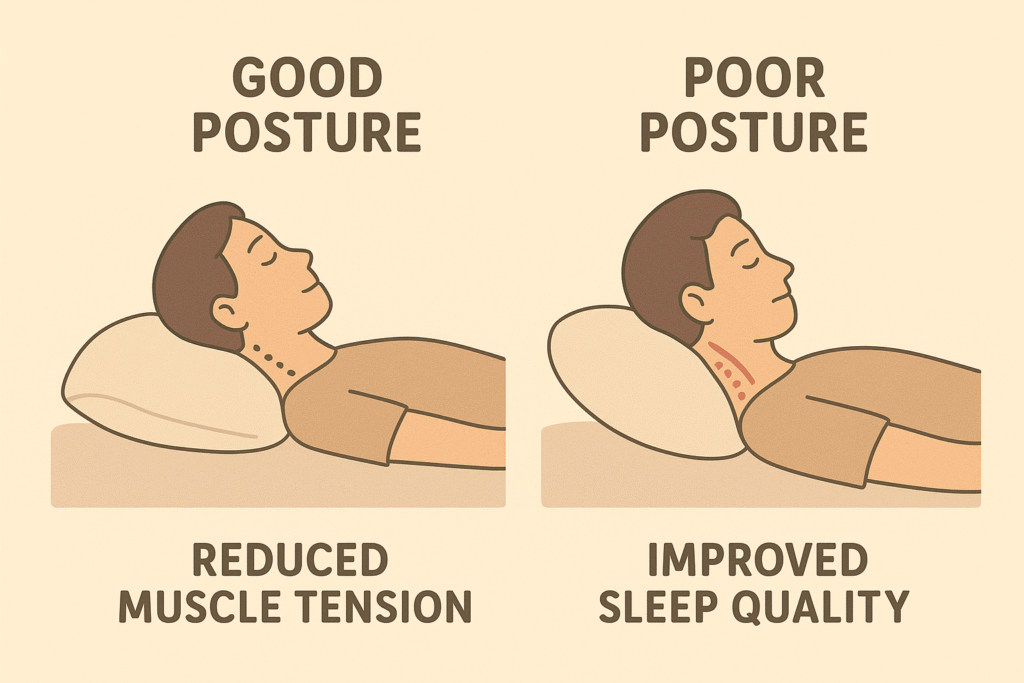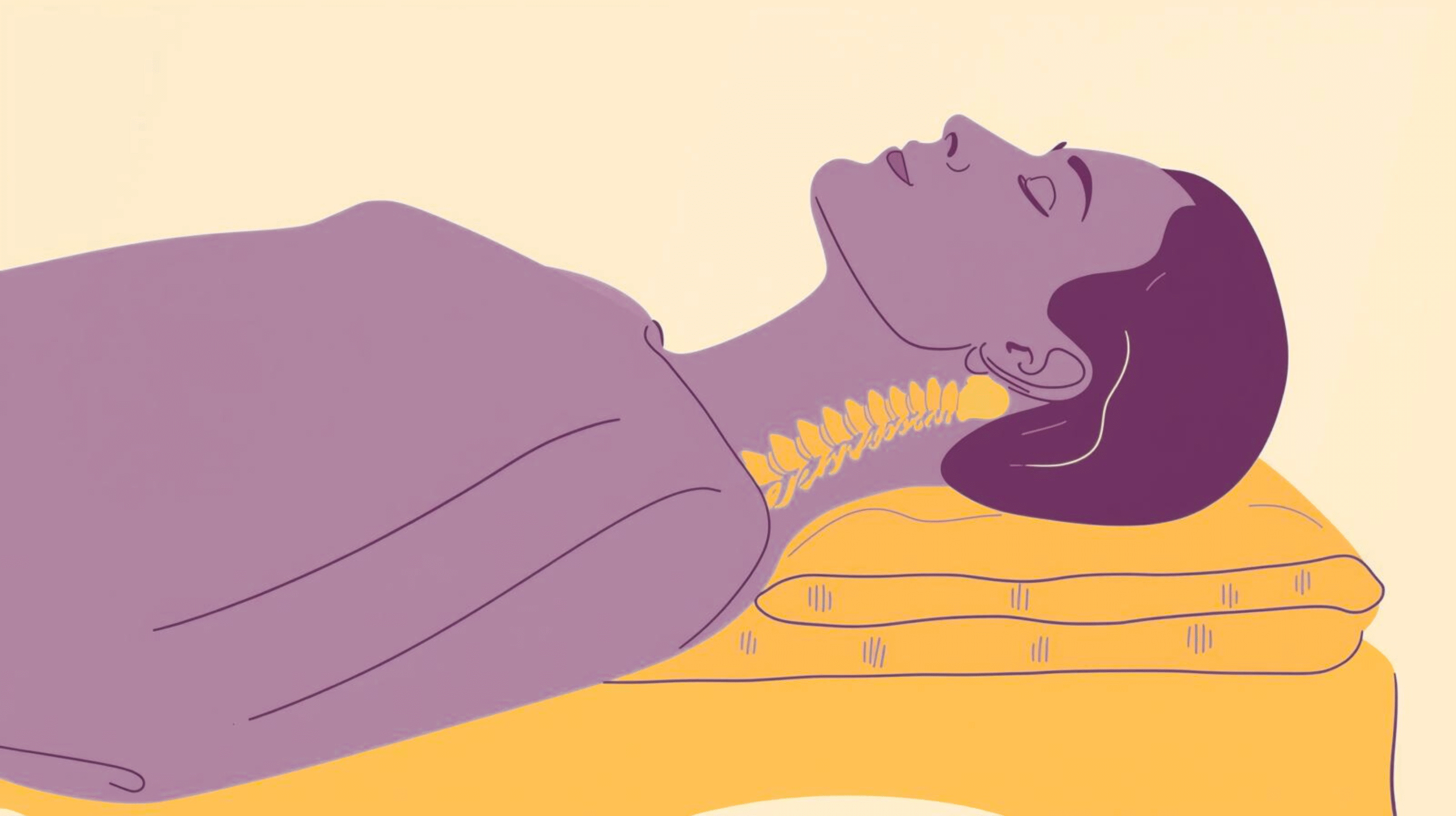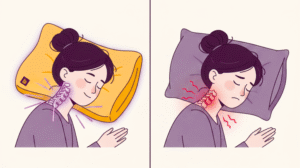The reasons behind neck pain these days include using a smartphone, poor posture, and spending the whole day sitting at a desk for jobs. You need to be aware of the daily routine that you follow, how you sleep and what pillow you sleep on. Flat pillows, which are also known as low-loft pillows, are gaining increased popularity as they help with neck pain (for those who lie on their backs or stomachs). However, they may not fit everybody, particularly those who sleep on their sides or those with neck issues. Their pros and cons are addressed in this article as well as the way they can alleviate pain in the neck.
Understanding Neck Pain and Sleep Posture
The cervical spine, made up of seven vertebrae (C1-C7), supports the head’s weight and allows flexibility [1]. Its natural inward curve (lordosis) helps distribute pressure evenly. When posture or pillow height disrupts this alignment, muscles, ligaments, and discs experience excess strain, leading to pain. Common causes include muscle strain, cervical spondylosis, herniated discs, injuries, and lifestyle factors like prolonged screen use.
Because we spend nearly a third of life sleeping, pillow choice plays a crucial role in either easing or worsening neck pain.
Sleep Posture
- Side sleepers: Needs a thicker pillow to fill the shoulder gap. Flat pillows usually cause misalignment.
- Back sleepers: Best supported by a low-loft pillow (1-3 inches), preventing forward head tilt.
- Stomach sleepers: Generally discouraged but, if unavoidable, a very thin pillow reduces neck rotation.
Pillow Thickness
Research shows pillow loft directly affects cervical alignment [2]. High pillows push the head forward; very thin ones cause droop or hyperextension. Flat pillows benefit back and stomach sleepers but are rarely ideal for side sleepers.
What is a Flat Pillow?
A flat pillow, also known as a low-loft pillow, is a pillow designed with reduced thickness; generally less than three inches in height. Unlike traditional high-loft or contoured pillows, flat pillows provide minimal elevation of the head and neck. Their primary purpose is to reduce unnatural bending of the cervical spine during sleep by keeping the head closer to the mattress surface.
Characteristics of Flat Pillows
- Height (Loft): Usually 1-3 inches.
- Shape: Simple rectangular or square; may lack the curves seen in orthopedic pillows.
- Firmness: Available in soft, medium, and firm densities depending on the filling material.
- Target Users: Best suited for back and stomach sleepers; often unsuitable for side sleepers due to inadequate shoulder support.
Types of Flat Pillows
- Memory Foam Flat Pillow
- Conforms to the shape of the head and neck.
- Provides consistent support and resists flattening.
- Often medium-firm, making it ideal for back sleepers.
- Latex Flat Pillow
- Offers resilience and bounce.
- Naturally hypoallergenic and resistant to dust mites.
- Provides a firmer feel compared to memory foam.
- Feather or Down Flat Pillow
- Soft and lightweight.
- Breathable and moldable but tends to flatten over time.
- Requires frequent fluffing.
- Cotton-Filled Flat Pillow
- Traditional and inexpensive.
- Breathable but less durable.
- Often becomes too thin with prolonged use.
Flat Pillows vs Traditional High-Loft Pillows
- Traditional High-Loft Pillows: Usually 4-6 inches in height, designed to lift the head more significantly. These are often preferred by side sleepers.
- Flat Pillows: Provide minimal lift, which is beneficial for maintaining neutral alignment in back and stomach sleeping.
While many people instinctively choose thicker pillows thinking they provide more comfort, a flat pillow can sometimes be more effective in reducing strain on the neck; especially for individuals whose cervical curve is compromised by excessive forward or backward bending.
Benefits of Flat Pillows for Neck Pain
Flat pillows are not universally ideal, but for the right sleeper type and condition, they can offer remarkable benefits. Let us explore their advantages in detail.
Promotes Proper Cervical Alignment
The greatest advantage of flat pillows is their ability to help maintain neutral cervical alignment, particularly in back and stomach sleepers. When the pillow height is appropriate, the neck neither flexes forward nor extends backward excessively.
Pillow height directly influences muscle activity and cervical spine loading [3]. Flat pillows often fall within the lower height range that minimizes abnormal strain.

By promoting alignment, flat pillows may:
- Prevent morning stiffness.
- Reduce the risk of tension headaches caused by muscle tightness.
- Support the natural curvature of the cervical spine.
Ideal for Back Sleepers
Back sleeping requires a pillow that supports the natural curve without forcing the head forward. A pillow that is too thick lifts the head, bending the neck forward and straining muscles. Conversely, a pillow that is too thin may cause hyperextension. Flat pillows, particularly memory foam or medium-firm varieties, provide a middle ground; enough support to cradle the head without excessive elevation.
Back sleepers often report reduced snoring and improved breathing when using flat pillows, as the airway remains unobstructed.
May Reduce Muscle Strain
High-loft pillows elevate the head significantly, which can strain the trapezius, levator scapulae, and cervical extensors. Over time, this may cause muscle knots, pain radiating to the shoulders, or restricted neck movement.
Flat pillows reduce this unnatural bending, particularly for individuals who already experience muscle tightness from desk jobs or forward-head posture. In this way, they act as a preventive tool against accumulated muscular fatigue.
Can Benefit Stomach Sleepers
Stomach sleeping is generally discouraged by sleep experts because it forces the neck into extreme rotation, which can stress joints and muscles. However, some individuals cannot avoid this posture. In such cases, a very thin pillow or a flat pillow provides the least strain.
Without a pillow, stomach sleepers may feel discomfort in the chest or ribs. Flat pillows strike a balance, supporting the head lightly while minimizing cervical twisting.
Lightweight and Breathable Options
Flat pillows, particularly cotton and feather-filled varieties, are lightweight and breathable [4]. They allow better air circulation and are easier to reposition during sleep. This makes them a good choice for people who dislike the heaviness of contoured orthopedic pillows.
Additionally, being less bulky, flat pillows are easier to pack while traveling, allowing consistent neck support even away from home.
Risks and Limitations of Using Flat Pillows
Despite their benefits, flat pillows are not without drawbacks. They are not universally beneficial and, in some cases, may worsen neck pain.
Not Suitable for Side Sleepers
Side sleeping requires significant support to bridge the gap between the shoulder and head. A pillow that is too flat causes the head to tilt downward, straining the cervical spine and shoulders.
Side sleepers using low-loft pillows experienced more discomfort and reduced sleep quality compared to those using thicker or contoured pillows [5].
For side sleepers, flat pillows are generally inadequate unless paired with an adjustable insert or additional cushioning.
Possible Worsening of Cervical Pain
Flat pillows may not provide enough support for individuals with cervical spondylosis, arthritis, or degenerative disc disease. In such cases, maintaining proper spinal curves is crucial, and inadequate elevation may exacerbate pain.
A very flat pillow can also promote hyperextension in back sleepers if not carefully chosen. This may lead to nerve compression, tingling in arms, or worsening of pre-existing cervical issues.
Poor Durability in Some Materials
Not all flat pillows are created equal. Cotton and feather flat pillows, while breathable, tend to lose shape quickly. Over time, they compress further, becoming too thin to provide support. This not only reduces comfort but also requires frequent replacement.
In contrast, memory foam or latex flat pillows are more durable, though they can be more expensive.
One-Size-Does-Not-Fit-All
The biggest limitation of flat pillows is their lack of universality. What works for a back sleeper may cause discomfort in a side sleeper. Similarly, someone with a naturally larger shoulder width or deeper cervical curve may find flat pillows insufficient.
This is why sleep experts recommend trial and error, often suggesting individuals test a flat pillow for at least 7-14 nights before making a final decision. Personalized selection is key.
Flat Pillow vs Other Pillow Types
Flat pillows are simple and lightweight, but not always the best choice for everyone. Here’s how they compare with other pillow types:
Flat vs Cervical Pillow
Cervical pillows have contours that support the neck’s curve [6]. They’re great for people with cervical issues or disc problems but can feel bulky and restrictive. Flat pillows, on the other hand, are minimalist and better for mild discomfort.
Flat vs Memory Foam Pillow
Memory foam molds to the head and neck, offering pressure relief and durability. Flat pillows are lighter and more breathable but less supportive. Back sleepers may prefer a low-loft memory foam hybrid.
Flat vs Wedge Pillow
Wedge pillows elevate the upper body, helping with reflux or snoring, but they’re not designed for neck support. Flat pillows directly target cervical alignment.
Flat vs Adjustable Loft Pillow
Adjustable pillows let users change thickness for any sleep style but are heavier and pricier. Flat pillows are simpler, though less adaptable.
Choosing the Right Flat Pillow for Neck Pain
Finding the right flat pillow means considering material, loft, and firmness.
Factors to Consider
- Material: Memory foam (durable, contouring), latex (firm, hypoallergenic), feather/down (soft, breathable, flattens quickly), cotton (cheap but loses shape fast).
- Loft: Back sleepers need 2-3 inches; stomach sleepers 1-2 inches; side sleepers usually need a higher loft.
- Firmness: Medium-firm is best for most; too soft lacks support, too firm may feel rigid.
Recommended Options
- Back sleepers: Medium-firm memory foam (~2.5″).
- Stomach sleepers: Ultra-flat cotton/feather (~1″).
- Combination sleepers: Latex (~2″).
Tips for Adjustment
Try inserts (e.g., a towel under a pillow), test for 1-2 weeks, and watch for morning stiffness or headaches. Match pillow with mattress; softer beds may need slightly more loft.
Expert Opinions and Research Findings
Scientific research and professional recommendations provide valuable insight into whether flat pillows truly benefit neck pain sufferers.
Research Evidence
- Pillow Height and Cervical Spine Biomechanics
- A study found that pillow height significantly influences muscle activity in the neck and loading on cervical joints [7].
- Too high or too low pillows caused increased strain, while low-loft pillows were often optimal for back sleepers.
- Pillow Comfort and Pain Reduction
- Side sleepers concluded that low-loft pillows were linked to reduced sleep quality and increased pain, reinforcing that pillow choice must match sleep position [8].
- Side sleepers concluded that low-loft pillows were linked to reduced sleep quality and increased pain, reinforcing that pillow choice must match sleep position [8].
- Randomized Controlled Trials on Cervical Pillows
- Cervical pillows reduced pain intensity and improved sleep in patients with chronic neck pain compared to standard pillows [9]. This shows that while flat pillows may help, cervical contour designs can be more effective for patients with severe conditions.
- Cervical pillows reduced pain intensity and improved sleep in patients with chronic neck pain compared to standard pillows [9]. This shows that while flat pillows may help, cervical contour designs can be more effective for patients with severe conditions.
- Ergonomics in Sleep
- A study emphasized the importance of pillow and mattress synergy in maintaining spinal alignment [10]. Even the best pillow cannot compensate for an unsupportive mattress.
Chiropractors’ and Sleep Experts’ Recommendations
- Chiropractors often recommend low-loft flat pillows for back sleepers to maintain neutral cervical alignment.
- Physiotherapists caution that side sleepers usually need more loft and should avoid flat pillows unless customized with inserts.
- Sleep Medicine Specialists emphasize individualized choice, highlighting that no single pillow type works for everyone, and trial periods are essential.
Practical Tips for Neck Pain Relief Beyond Pillow Choice
A flat pillow helps, but long-term relief requires healthy habits and posture care.
Stretching & Strengthening
Regular exercises like chin tucks, neck rotations, side bends, and shoulder blade squeezes improve flexibility and stability. Yoga or Pilates can further release tension.
Ergonomic Setup
Keep monitors at eye level, elbows at 90°, and use a supportive chair. Follow the 20-20-20 rule to reduce screen strain.
Posture Awareness
Avoid forward head posture, which adds heavy stress to the cervical spine. Hold devices at eye level, take breaks, and keep ears aligned with shoulders.
Sleep Routine
Stick to consistent sleep cycles, use a medium-firm mattress, and avoid awkward positions like resting on the arm.
Conclusion
In case you sleep on your back or stomach, a flat pillow can be used to relieve neck pain as they help in maintaining your natural cervical position. However, they cannot be effectively used by everyone, and the side sleepers typically require more contoured options. The kind of pillow to use generally depends on your sleeping habits and how your spine requires them to be. Many consider that flat pillows are quite effective, affordable and can be carried anywhere. You also, however, need to change your sleeping schedule, make some ergonomic adjustments and visit a doctor, in case you don’t recover.
If you want to know more about different aspects of pillow, have a look at these:
Frequently Asked Questions
1. Are flat pillows good for neck pain?
Yes, but only for certain sleepers. Flat pillows are especially helpful for back and stomach sleepers as they maintain a neutral cervical alignment. For side sleepers, however, flat pillows usually do not provide enough loft, leading to neck and shoulder strain.
2. Which sleeping position benefits most from a flat pillow?
Back sleepers benefit the most, since flat pillows prevent the head from being pushed forward. Stomach sleepers also find relief because thin pillows reduce neck twisting and compression.
3. Can a flat pillow worsen cervical spondylosis?
Yes, in some cases. People with degenerative cervical conditions often require specialized contour or orthopedic pillows to maintain proper alignment. A very flat pillow might allow excessive neck extension, worsening pain. Consulting a physician or physiotherapist is advised.
4. Is a memory foam flat pillow better than a cotton flat pillow?
Generally, yes. Memory foam maintains its shape, provides consistent support, and lasts longer. Cotton pillows tend to flatten further with use, reducing support over time. However, cotton may feel cooler and lighter for hot sleepers.
5. How do I know if my pillow is too flat for neck support?
Signs include waking up with stiffness, headaches, or pain radiating to the shoulders. If your head tilts backward (for back sleepers) or downward (for side sleepers), your pillow is likely too flat.
References
- Waxenbaum, J. A., Reddy, V., Black, A. C., & Futterman, B. (2017). Anatomy, back, cervical vertebrae. https://europepmc.org/article/NBK/nbk459200
- Ren, S., Wong, D. W. C., Yang, H., Zhou, Y., Lin, J., & Zhang, M. (2016). Effect of pillow height on the biomechanics of the head-neck complex: investigation of the cranio-cervical pressure and cervical spine alignment. PeerJ, 4, e2397. https://doi.org/10.7717/peerj.2397
- Lei, J. X., Yang, P. F., Yang, A. L., Gong, Y. F., Shang, P., & Yuan, X. C. (2021, October). Ergonomic consideration in pillow height determinants and evaluation. In Healthcare (Vol. 9, No. 10, p. 1333). MDPI. https://doi.org/10.3390/healthcare9101333
- Cafuta, D., Abu-Rous, M., Jary, S., Scheffelmeier, M., & Rijavec, T. (2019). Suitability of lyocell fiber for pillow fillings. Textile Research Journal, 89(18), 3722-3743. https://doi.org/10.1177/0040517518819844
- Radwan, A., Ashton, N., Gates, T., Kilmer, A., & VanFleet, M. (2021). Effect of different pillow designs on promoting sleep comfort, quality, & spinal alignment: A systematic review. European Journal of Integrative Medicine, 42, 101269. https://doi.org/10.1016/j.eujim.2020.101269
- Kim, M. R., Chung, J. Y., Lee, D. Y., Hong, J. H., Kim, J. S., Yu, J. H., & Jung, S. (2016). The influence of pillow material and shape on cervical curvature stability. Indian J Sci Technol, 9(47). DOI: 10.17485/ijst/2016/v9i47/108373
- Kim, H. C., Jun, H. S., Kim, J. H., Ahn, J. H., Chang, I. B., Song, J. H., & Oh, J. K. (2015). The effect of different pillow heights on the parameters of cervicothoracic spine segments. Korean Journal of Spine, 12(3), 135. doi: 10.14245/kjs.2015.12.3.135
- Zhong, D., Lin, C. C., Hsieh, Y. L., Liao, W. Y., Chan, C. Y., & Chou, L. W. (2025). The effect of the air massage pillow for individuals with neck pain: a randomized double-blind, cross-over study. QJM: An International Journal of Medicine, hcaf161. https://doi.org/10.1093/qjmed/hcaf161
- Lavin, R. A., Pappagallo, M., & Kuhlemeier, K. V. (1997). Cervical pain: a comparison of three pillows. Archives of Physical Medicine and Rehabilitation, 78(2), 193-198. https://doi.org/10.1016/S0003–9993(97)90263-X
- Hong, T. H. (2023). Biomechanical study of sleeping support and system optimization based on spine alignment. https://theses.lib.polyu.edu.hk/handle/200/12279



















